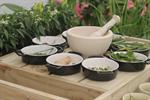 Spices come from the aromatic parts of plants which are dried. This includes seeds, bark, roots, leaves, fruit – in fact, all plant parts may have some use, depending on the particular plant. For instance, the dried seeds of coriander may be ground into a powder for use in Asian cuisine, or the roots of ginger can be treated in the same way. Although some spices are used fresh, like fresh coriander leaves and fresh ginger root, to qualify as a spice it must be dried before use. Therefore, some plants may be considered as a herb or vegetable when leafy or fresh parts are used in cooking or for garnishing, but also as a spice when parts are dried. Salt, which is often grouped with spices, is not a true spice. It is a mineral which is mined from the ground and unlike spices it retains its flavour over time.
Spices come from the aromatic parts of plants which are dried. This includes seeds, bark, roots, leaves, fruit – in fact, all plant parts may have some use, depending on the particular plant. For instance, the dried seeds of coriander may be ground into a powder for use in Asian cuisine, or the roots of ginger can be treated in the same way. Although some spices are used fresh, like fresh coriander leaves and fresh ginger root, to qualify as a spice it must be dried before use. Therefore, some plants may be considered as a herb or vegetable when leafy or fresh parts are used in cooking or for garnishing, but also as a spice when parts are dried. Salt, which is often grouped with spices, is not a true spice. It is a mineral which is mined from the ground and unlike spices it retains its flavour over time.
Some spices (e.g. cinnamon, pepper and cloves) grow in the tropics, and are unlikely to be grown in your home garden, but many others are remarkably easy to grow and produce at home. You may wonder why go to so much trouble when they are relatively cheap to buy – the simple answer is you can have purer, fresher and often healthier and richer flavours if you grow the plants and produce the spices yourself. You also have a ready supply of plant parts so you can create more spices as and when a batch becomes depleted or loses its flavour.
How to Process the Plant into the Spice
When you first grind your own spices you will be amazed by the fragrance. The traditional method of grinding is the mortar and pestle, but grinders and blenders can also be used. Before you grind dried seeds, you can toast them in a frying pan on a medium heat for 30 seconds or until they pop. Once ground, transfer spices into airtight containers immediately, or use in cooking.
- Mortar & pestle – the mortar is the bowl into which dried plant parts are placed. They are then ground with a hand-held pestle. Connoisseurs would argue that the best types are those made of sturdy materials like granite and stone because they are strong, create enough friction to aid with grinding, and are easy to clean. Look for ones with a deep and wide, rounded bowl and a broader, gently rounded pestle. Avoid wooden and metal versions because rounded plant parts and seeds will readily escape when pressed down. A mortar and pestle allows you to grind even tiny amounts at a time compared to grinders.
- Electronic grinding machines – electronic grinders are very popular because they require less effort than manual types.
- Blenders – a food blender may be used for some plant parts although it is unlikely to produce very fine powders and would not suit small quantities.
- Manual grinders – these types range from tabletop versions with crank handles like coffee grinders, to those which clamp to kitchen benches and look more like meat grinders.
- Coffee grinders – some people use these for grinding spices. If you plan on using it to grind coffee in the future then it must be thoroughly cleaned otherwise the coffee beans will be tainted with the aroma of spices.
- Pepper mill – you can use a pepper mill with some seeds other than pepper. For instance, coriander seeds lend themselves well to a pepper mill.